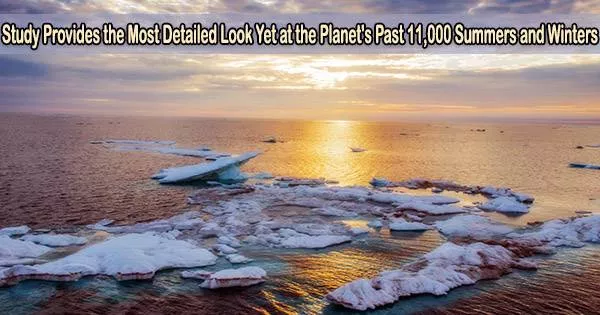Scientists from CU Boulder and a global team of colleagues have analyzed Antarctic ice cores to reveal the most thorough look yet at the planet’s recent climatic history, including summer and winter temperatures going back 11,000 years to the start of the Holocene.
The study, which was just published in Nature, is the world’s first seasonal temperature record of its kind.
“The goal of the research team was to push the boundaries of what is possible with past climate interpretations, and for us that meant trying to understand climate at the shortest timescales, in this case seasonally, from summer to winter, year-by-year, for many thousands of years,” said Tyler Jones, lead author on the study, and assistant research professor and fellow at the Institute of Arctic and Alpine Research (INSTAAR).
The research also confirms a previously unproven part of a long-held notion about Earth’s climate: the Milankovitch cycle response of seasonal temperatures in the polar regions.
Serbian scientist Milutin Milankovitch hypothesized a century ago that the collective effects of changes in Earth’s position relative to the sun due to slow variations of its orbit and axis are a strong driver of Earth’s long-term climate, including the start and end of ice ages (prior to any significant human influence on the climate).
“I am particularly excited that our result confirms a fundamental prediction of the theory used to explain Earth’s ice-age climate cycles: that the intensity of sunlight controls summertime temperatures in the polar regions, and thus melt of ice, too,” said Kurt Cuffey, a co-author on the study and professor at the University of California Berkeley.
Other scientists that research the effects of greenhouse gas emissions caused by human activity on our present and future climate might utilize this more in-depth data on historical long-term climate trends as a baseline. Researchers can more accurately determine the human influence on climate change and its effects on global temperatures by understanding which planetary cycles occur naturally and why.
“This research is something that humans can really relate to because we partly experience the world through the changing seasons documenting how summer and winter temperature varied through time translates to how we understand climate,” said Jones.
Humans have a fundamental curiosity about how the world works and what has happened in the past, because that can also inform our understanding of what could happen in the future.
Tyler Jones
Finer definition amidst diffusion
Ice cores collected from the poles have long been used by scientists all around the world to study Earth’s past climate. These thin, cylindrical columns of ice are locked in time and were created by drilling through old ice sheets, especially in Antarctica and Greenland. They provide vital information on previous atmospheric greenhouse gas concentrations, past air and ocean temperatures, and more.
The West Antarctic Ice Sheet (WAIS) Divide ice core, the longest ice core ever drilled by U.S. researchers, measures 11,171 feet (or over 2 miles) long and 4.8-inches in diameter containing data from as old as 68,000 years ago.
After being carefully divided into smaller pieces, ice cores like this one can be safely transported to, kept in, or examined at ice core labs around the nation, including the Stable Isotope Lab at CU Boulder.
The WAIS ice core’s continuous record of water-isotope ratios was examined for this investigation. The ratios between the concentration of these isotopes (elements with the same number of protons but different numbers of neutrons) reveal data about past temperatures and atmospheric circulation, including transitions between ice ages and warm periods in Earth’s past.
However, the exquisite information needed for their shorter durations makes it particularly challenging to measure seasonal variations in the history of our planet from ice cores. This crucial detail may be lost due to a process in ice sheets known as diffusion, sometimes known as natural smoothing.
As they transition between the vapor and ice phases over decades or millennia, these water isotopes in the upper ice sheet frequently travel around in networked pathways (similar to the air pockets in Styrofoam) before properly freezing. This process can “blur” the data researchers are trying to examine.
But by using the high-quality ice cores from the West Antarctic Ice Sheet, extremely high-resolution measurements and advances in ice core analysis from the past 15 years, the team was able to correct for the diffusion present in the data and complete the study.
“Even beyond that, we had to develop new methods entirely to deal with this data, because no one’s ever seen it before. We had to go above and beyond what anyone’s done in the past,” said Jones.
Studying stable isotopes
While the report traces the evolution of Earth’s climate, the research that went into it has a long history.
The Stable Isotope Lab at INSTAAR has spent more than three decades studying a range of stable isotopes, nonradioactive atom forms that are present in everything from the air in our atmosphere to the carbon in permafrost and ice cores. Jones joined the lab in 2007 as a master’s student and has never left.
“I have this distinct memory of walking into my advisor, Jim White’s office in about 2013, and showing him that we would be able to pull out summer and winter values in this record for the last 11,000 years which is extremely rare. In our understanding, no one had ever done this before,” said Jones. “We looked at each other and said, ‘Wow, this is going to be a really big deal.’”
The process of correctly interpreting the data from ice cores that were drilled several years prior to that meeting took over a decade.
Bruce Vaughn, co-author and a chief scientist on the project, and manager of the Stable Isotope Lab, and Bradley Markle, co-author on the study and assistant professor at INSTAAR and the Department of Geology, were there to collect the ice in West Antarctica that was shipped back and analyzed.
The team’s next step is to attempt to interpret high-resolution ice cores in other locations where cores have already been dug to better understand our planet’s climate variability, such as the South Pole and northeast Greenland.
“Humans have a fundamental curiosity about how the world works and what has happened in the past, because that can also inform our understanding of what could happen in the future,” said Jones.
















